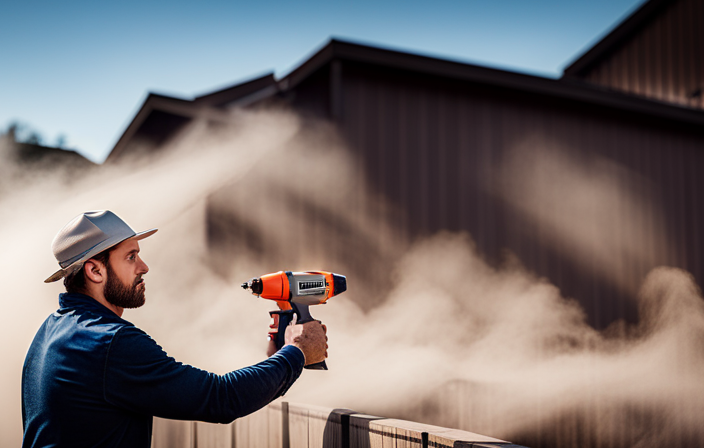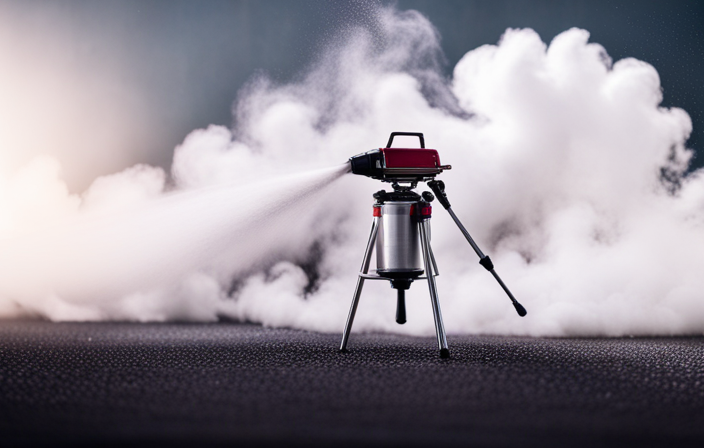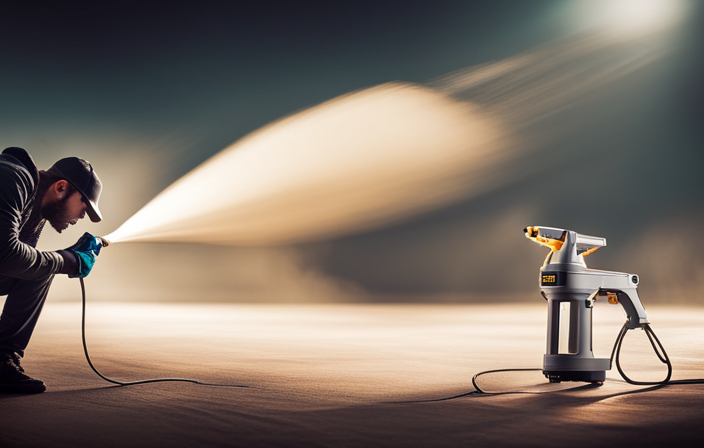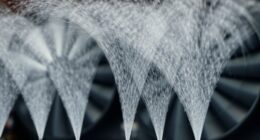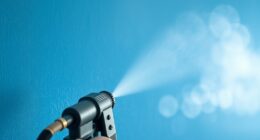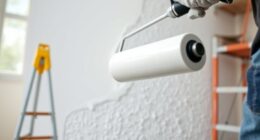Are you ready to enhance your painting skills? If so, consider using the Graco airless paint sprayer. This powerful tool will transform the way you paint, streamlining the process and making it faster, easier, and more effective.
With the Graco airless paint sprayer, you can achieve a professional-quality finish in no time.
In this article, I will guide you through the step-by-step process of using the Graco airless paint sprayer. From setting up your work area to troubleshooting common issues, I will share my knowledge and experience to ensure that you get the best results possible.
So, whether you’re a seasoned painter or a DIY enthusiast, get ready to elevate your painting game with the Graco airless paint sprayer. Let’s dive in and discover the secrets to achieving flawless, smooth, and even paint coverage.
Key Takeaways
- Clean the nozzle or adjust the pressure to fix uneven spraying
- Check and clean the filters to resolve paint clogging
- Verify the power source if the sprayer isn’t turning on
- Choose the right paint for the project and follow the manufacturer’s instructions for best results
Set Up Your Work Area
Now, let’s get started by setting up your work area for optimal painting with the Graco airless paint sprayer.
Work area organization is key to a smooth painting process. Clear any clutter and ensure you have enough space to move around comfortably. Place a drop cloth or plastic sheeting to protect the surrounding surfaces from any overspray.
Safety precautions are of utmost importance when using the paint sprayer. Wear protective goggles, a mask, and gloves to shield yourself from any potential hazards. Make sure there aren’t any flammable materials nearby and that the area is well-ventilated.
With your work area organized and safety measures in place, we can now move on to preparing your paint and sprayer for a flawless finish.
Prepare Your Paint and Sprayer
Before diving into the world of painting with the power of a mighty sprayer, it’s crucial to ensure your colors are mixed to perfection and your tool is eagerly awaiting its turn.
Choosing the right paint type is essential for achieving a flawless finish. Whether you’re using latex, oil-based, or specialty paint, make sure it’s compatible with your Graco airless paint sprayer.
Additionally, proper ventilation is key to creating a safe and comfortable work environment. Open windows or use fans to ensure fresh air circulation and prevent the inhalation of harmful fumes.
With your paint mixed and your work area well-ventilated, you’re now ready to move on to the next step: adjusting the spray pattern and pressure to achieve the desired results.
Adjust the Spray Pattern and Pressure
To achieve the perfect finish, you’ll want to make sure you adjust the spray pattern and pressure just right. The Graco airless paint sprayer allows you to easily control the paint flow and adjust the spray nozzle to achieve the desired result. By adjusting the spray pattern, you can choose between a narrow or wide spray width, depending on the surface you are painting. The pressure can be adjusted to control the amount of paint being sprayed, ensuring even coverage without any drips or streaks.
To make it easier to understand, here is a table summarizing the adjustments you can make:
| Aspect | Adjustment |
|---|---|
| Spray Pattern | Narrow or Wide |
| Spray Width | Adjust the spray nozzle |
| Paint Flow | Control the pressure |
Now that you have adjusted the spray pattern and pressure, it’s time to test the sprayer on a scrap surface to ensure everything is working as desired.
Test the Sprayer on a Scrap Surface
Once you’ve fine-tuned the spray pattern and pressure, it’s time to put the sprayer to the test on a scrap surface, allowing your creativity to come to life with each stroke.
Before you begin, it’s crucial to prioritize your safety by wearing the appropriate protective gear. Goggles, gloves, and a respirator will shield you from any potential hazards, ensuring a worry-free painting experience.
When selecting the right type of paint for the test surface, consider its texture and material. For example, if you’re spraying on wood, choose a paint that’s specifically formulated for wood surfaces. This will ensure proper adhesion and a flawless finish.
As you test the sprayer and evaluate the results, keep in mind that the next step is to start painting from top to bottom, achieving professional-looking results effortlessly.
Start Painting from Top to Bottom
Now that you’ve mastered the spray pattern and pressure, it’s time to unleash your creativity by starting your painting journey from top to bottom.
Here are some pros and cons of this technique and the best techniques to follow:
-
Pros: Starting from the top ensures that any drips or overspray will be covered as you move down. It also allows for a more even application and reduces the chances of streaks or uneven coverage.
-
Cons: Gravity can sometimes work against you, causing paint to drip or run if you don’t maintain a consistent distance from the surface. It can also be challenging to reach higher areas without a ladder or extension pole.
-
Best techniques: Begin by painting the ceiling and then move on to the walls, windows, and doors. Remember to overlap each stroke by about 50% to achieve a uniform finish. Keep a steady pace and maintain a consistent distance of about 12 inches from the surface.
By following these techniques, you can achieve professional-looking results.
In the next section, we’ll discuss how to maintain a consistent distance from the surface to ensure an even coat of paint.
Maintain a Consistent Distance from the Surface
Ensure that you always keep a steady hand and maintain a consistent distance from the surface, or risk creating a disastrous mess of uneven paint coverage.
When using a Graco airless paint sprayer, it’s crucial to maintain the correct distance between the sprayer and the surface being painted. This distance is typically around 12 inches, but it may vary depending on the type of paint being used and the surface texture.
By maintaining this distance, you can prevent overspray and achieve a smooth, even finish. It’s also important to move the sprayer in a steady, consistent motion to avoid any streaks or lines. Remember to overlap each stroke for even coverage, ensuring that no spots are missed.
This technique will help you achieve professional-looking results.
Transitioning into the next section, it’s equally important to understand how to overlap each stroke for even coverage.
Overlap Each Stroke for Even Coverage
To achieve a flawless finish, it’s important to make sure each stroke overlaps for even coverage. This technique ensures that there are no gaps or uneven patches in your paint job. To achieve the best results, follow these overlap techniques:
-
Start each stroke slightly before the previous one ends. This helps to blend the paint and create a seamless finish.
-
Maintain a consistent speed and pressure throughout the entire stroke. This will help to ensure an even distribution of paint.
-
Make sure to overlap each stroke by about 50%. This ensures that the paint is applied evenly and prevents any streaks or lines.
By following these techniques, you can achieve a smooth finish that looks professional and uniform.
Now, let’s move on to the next step of cleaning the sprayer after use.
Clean the Sprayer After Use
After you’ve finished painting, it’s essential to properly clean and maintain your sprayer to ensure its longevity and optimal performance. Cleaning the sprayer after use is a crucial step in preventing clogs and maintaining its efficiency.
Start by removing the paint container and emptying any remaining paint. Next, disassemble the sprayer components and rinse them thoroughly with water. Pay close attention to the nozzle and filters, as these areas are prone to buildup. Use a small brush or toothbrush to remove any stubborn residue.
Once everything is clean, allow the components to air dry before reassembling the sprayer. Proper storage is also important to prevent damage. Store the sprayer in a clean, dry place away from extreme temperatures.
To troubleshoot common issues, refer to the next section for guidance on solving problems that may arise during the painting process.
Troubleshoot Common Issues
Having trouble with your sprayer? Let’s troubleshoot some common issues and get you back to painting in no time!
When it comes to troubleshooting techniques for your Graco airless paint sprayer, there are a few common problems that you might encounter. One issue could be uneven spraying, which can be caused by a clogged nozzle or an incorrect spray pressure setting. To fix this, you can clean the nozzle or adjust the pressure accordingly.
Another problem could be paint clogging in the system, which can be resolved by checking the filters and ensuring they’re clean.
Lastly, if the sprayer isn’t turning on, check the power source and make sure it’s properly connected.
By addressing these common paint sprayer problems, you’ll be able to enjoy your professional-quality paint job without any hiccups.
Enjoy Your Professional-Quality Paint Job
Immerse yourself in the satisfaction of a flawless masterpiece, created with the stroke of a magical paintbrush. When using a Graco airless paint sprayer, achieving a professional-quality paint job is within reach.
To avoid paint drips and ensure a smooth finish, it’s crucial to choose the right paint for your project. Consider the type of surface you’re painting and the desired outcome. For example, if you’re painting a high-traffic area, opt for a durable and washable paint.
Additionally, using a primer can help improve adhesion and prevent peeling or cracking. By selecting the right paint and following the manufacturer’s instructions, you can enjoy a smooth and long-lasting paint job that’ll impress even the most discerning eye.
Frequently Asked Questions
What type of paint can I use with a Graco airless paint sprayer?
You can use various types of paint with a Graco airless paint sprayer, including latex, oil-based, and acrylic paints. To ensure optimal results, it is important to follow best practices such as thinning the paint if needed and cleaning the sprayer properly after each use.
How do I clean the filters in a Graco airless paint sprayer?
To clean the filters in a Graco airless paint sprayer, I recommend using a soft brush to remove any dried paint or debris. Then, rinse the filters with warm soapy water and let them dry thoroughly before reattaching. Regular cleaning and maintenance are essential for optimal performance.
Can I use a Graco airless paint sprayer for both indoor and outdoor projects?
Yes, you can use a Graco airless paint sprayer for both indoor and outdoor projects. It offers efficiency and versatility. However, it’s important to clean the filters regularly and maintain proper maintenance to ensure optimal performance.
How do I prevent clogging in a Graco airless paint sprayer?
Preventing clogging in a Graco airless paint sprayer is crucial. By regularly cleaning and filtering the paint, using the right nozzle size, and ensuring proper pressure settings, you can troubleshoot clogs effectively. Who wants their painting project to be interrupted by clogs?
Can I use a Graco airless paint sprayer for textured surfaces?
Yes, you can use a Graco airless paint sprayer for textured surfaces. However, it is important to note that it may require different techniques and adjustments compared to using it on smooth surfaces. Troubleshooting common issues is still necessary.
Conclusion
In conclusion, mastering the art of using a Graco airless paint sprayer is like uncovering a hidden gem in the world of home improvement. With a little practice, you’ll be able to transform your living space into a masterpiece that’ll leave your guests in awe.
So, go ahead and embrace the power of this remarkable tool, ’cause it holds the key to unlocking a world of professional-quality paint jobs. Get ready to paint with precision, finesse, and a touch of magic.
Happy painting!

